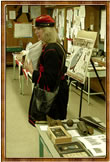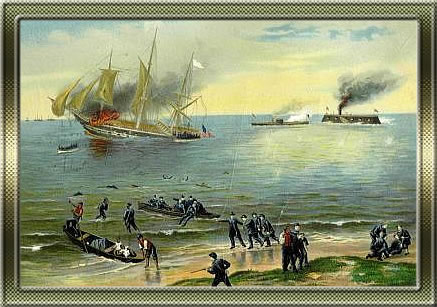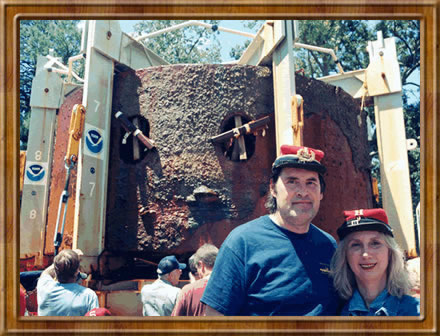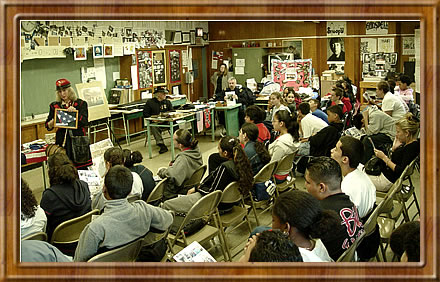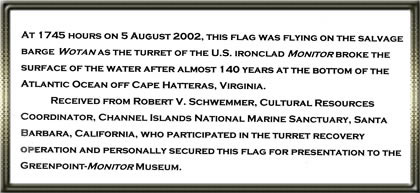THE GREENPOINT MONITOR MUSEUM
"ROAD SHOW"
May 7, 2004
Presented At:
J.H.S. 126 - "JOHN ERICSSON SCHOOL"
Page 3
CLICK IMAGES TO ENLARGE
Janice explains that when John Ericsson came to New York
in 1839,
the US Navy was still using wooden sailing ships
whose sails depended on the wind for power.
The wooden sailed frigate USS Constitution, which was
launched in 1797, was still in service and even
today can be seen in Boston, Massachusetts.
One of the last sailing frigates designed for the
United States Navy was the USS CONGRESS.
In the 1850's the US Navy included some wooden steam powered
frigates which also had auxiliary sails, but the older wind
powered frigates were still in use.
During the Civil War John Ericsson brought his plans for a
revolutionary type of ironclad warship to President Abraham Lincoln.
His new little warship had a steam engine, revolving turret, propeller,
shallow draft and was very low to the water.
He convinced President Abraham Lincoln to give the USS Monitor
a chance. John Ericsson came to Greenpoint to oversee the
construction of his new little warship at the Continental Iron Works.
George explains that the USS Monitor was completed and
arrived
just in time to save the US Navy at a naval battle which was taking
place at Hampton Roads, Virginia. Many of the US Navy's famous wooden
sailing frigates were sunk during this battle including the CONGRESS.
They were being destroyed by a Confederate ironclad
ship
called the CSS Virginia. Wood was no match to iron.
The ironclad USS Monitor saved the Union Navy on March
9, 1862
during this first battle between ironclads.
The USS Monitor fought against the CSS Virginia.
Although the USS Monitor fought against the CSS Virginia,
the battle is more commonly known as the
"Battle of the Monitor and Merrimac".
The Union Navy ship the USS Merrimac, which was steam
powered
with auxiliary sails, was rebuilt by the
Confederates. Her sails were removed and her hull was covered
with iron plate. She was then renamed the CSS Virginia.
Although the USS Monitor was smaller than the Merrimac,
John Ericsson's revolutionary design saved the day!
Geoge's cousin, Grenville Weeks, served on the
USS Monitor as an Assistant Surgeon.
His cousin was on the USS Monitor when
it sunk in a storm off Cape Hatteras on December 31, 1862
as it was being towed by the side wheeled steamer the Rhode Island.
After many years of searching, in 1973 the Monitor was
discovered
16 miles off Cape Hatteras, North Carolina under 230 feet of water.
It lay upside down with the turret under the ship.
The two 11 inch Dahlgren guns were still inside the turret.
In order to protect the Monitor, the site was designated
as the nation's first marine sanctuary on January 30, 1975.
The site is managed by the National Oceanic &Atmospheric Administration.
Over the years artifacts have been recovered from the Monitor
including her turret, steam engine, anchor, propeller, lantern
and miscellaneous smaller items belonging to the crew.
During Expedition 2002, the National Oceanic and
Atmospheric Administration together with the
US Navy recovered the USS Monitor's turret for
preservation and future display.
In recognition of The Greenpoint Monitor Museum's efforts
to establish a home for the Museum in Greenpoint, Brooklyn,
officers of the Museum were invited to participate in
NOAA's recovery efforts.
Janice showing flag from Salvage Barge Wotan.
Click
the "Greenpoint"
to Page 4
Return
to Page 2
THE
GREENPOINT MONITOR MUSEUM
P.O. Box 220378
Brooklyn, New York 11222-0378
718-383-2637
Janice
Lauletta-Weinmann, President, Webmaster
George J. Weinmann,
Webmaster
Copyright © 2002 Janice
& George J. Weinmann
All Rights Reserved.
